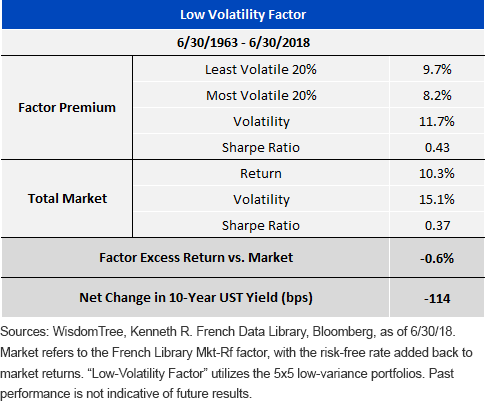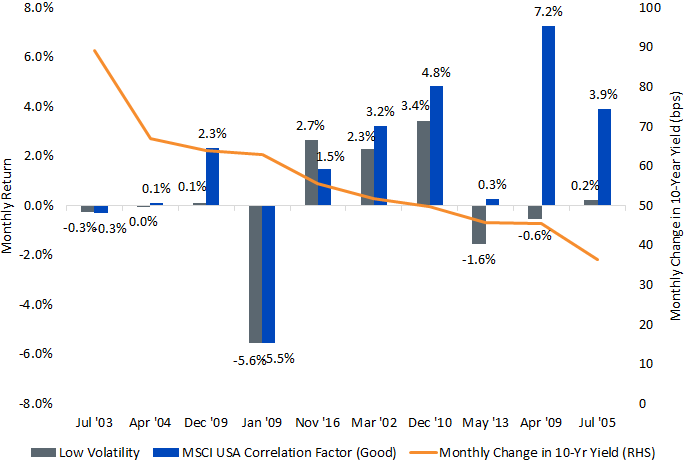The Impact of Rising Rates on Multifactor Strategies


With multifactor investing gaining traction in recent years, investors now have 440 multifactor ETFs and index mutual funds with a total of $74 billion in assets1 to choose from.
The investing community has largely accepted and focused on five primary factors—size, value, quality, momentum and low volatility—which serve as the bedrock of multifactor funds to varying degrees. When WisdomTree was researching its U.S. and global multifactor strategies, we wanted to include elements of these five as well.
However, we wanted to differentiate our approach by seeking a diversified set of alpha drivers focused on concentrated stock selection rules and portfolios with meaningful factor tilts. Investors have plenty of benchmark-hugging, low-tilt, low-tracking-error funds at their disposal. Our latest multifactor approach was designed to lean into and pursue high value-added stock selection while trying to balance the risks that come with more concentrated portfolios.
Of the single-factor strategies that have resonated with investors, low volatility stands out. WisdomTree did not include low volatility as an alpha-seeking pure stock selection factor in our methodology. There are ultimately two reasons why.
Reason One: Risk-Adjusted Returns Are Not Absolute Returns
The first reason we don’t include low volatility as an alpha component is because over long periods, low-volatility stocks have not consistently outperformed the market. Low-volatility stocks have historically outperformed high-volatility stocks over time and have delivered lower risk than the overall market. But the absolute excess performance of these stocks versus the market has historically been spotty.
This has held true over the last 50-plus years. Using the data from Professor Kenneth French’s database, the least volatile 20% of large-cap stocks have underperformed the market since 1963 by 0.6% per year. While low-volatility stocks have outperformed the most volatile stocks and had a higher Sharpe ratio than the market, the magnitude of their underperformance—compounded over such a large time frame—is hard to ignore.

Reason Two: Too Interested in Rates
The second reason for exclusion is because many low-volatility approaches—particularly those that are more recent and in our estimation looking forward—have an implicit interest rate sensitivity embedded in them, especially when loose or no sector constraints are implemented. Low-volatility equity investing has in recent years translated into a backdoor play on bond proxies, such as Utilities, Real Estate and Consumer Staples. These stocks can do quite well when interest rates fall, but typically underperform when rates rise.
This can be particularly problematic in market environments like what we experienced in early 2018. Stocks fell starting in late January, but because yields rose at the same time, low-volatility stocks underperformed in a volatile environment—the opposite of what many low vol investors had expected.
How Do We Reduce Volatility? Low Correlation
To help manage volatility, we’ve identified what we believe to be an underappreciated factor by the marketplace: low correlation.
Investors know from modern portfolio theory that combining assets with low correlations to each other can reduce portfolio volatility, and our approach utilizes that same framework. By focusing on stocks that are less correlated to the market, we can reduce our overall volatility in a way that is less sensitive to interest rates. An added benefit to this is a bias toward the size factor, as larger companies with greater representation in the market will by default have higher correlations than smaller companies.
Rising Rate Case Study
To highlight this rate sensitivity, here we examine the biggest monthly jumps in the 10-Year U.S. Treasury yield dating back to 2002. The analysis compares the least volatile 20% of large-cap stocks from Professor French’s database with an isolated basket of the lowest-correlated stocks versus the broader MSCI USA Index.
The low-correlation portfolio outperformed the low-volatility one in eight of the 10 biggest rising rate months, with an average outperformance of 1.7% per month. Perhaps most importantly, the low-correlation factor portfolio outperformed in four of the five months where low volatility had negative returns. Investors looking to low-volatility strategies for downside protection may be better off looking to low correlation to more effectively achieve their desired outcome.


For definitions of terms in the chart, please visit our glossary.
Final Thoughts on Low Correlation
There are other reasons we chose low correlation as one-fourth of our multifactor strategy stock selection process. For one, we have high conviction in our value, quality and momentum stock selection models, so key methodology choices such as sector neutrality and the low-correlation factor help reduce sector and market risk, and thus magnify stock selection. In addition, we do include low volatility by weighting each stock by a combination of its composite factor score and inverse volatility ranking, but only after we select stocks that we believe have more robust alpha-focused factor exposures via value, quality, momentum and low correlation. This marries an alpha-oriented selection process with a risk-managed weighting process.
The U.S. version of our multifactor strategy now has more than a one-year track record, and we couldn’t be happier with the results, having outperformed each of the 10 largest multifactor ETFs on an absolute and risk-adjusted basis since launching last June (it may or may not be a coincidence that this outperformance occurred during a 70 basis points (bps) rise in yields over that time). The success of the U.S. strategy has helped usher in the recent launch of its sister ETFs in the international developed and emerging markets universes, where we’re marrying dynamic currency hedging overlay strategies on top of our proven multifactor process.
Given the consensus market view of higher rates in the future, hopefully down the road we can report back with similar results for those strategies as well.
1Source: Morningstar, “A Framework for Analyzing Multifactor Funds,” as of 4/30/18.
Important Risks Related to this Article
There are risks associated with investing, including possible loss of principal. Investing in a Fund exposed to particular sectors increases the vulnerability to any single economic, political or regulatory development. This may result in greater share price volatility. Due to the investment strategy of the Fund, it may make higher capital gain distributions than other ETFs. Please read the Fund’s prospectus for specific details regarding the Fund’s risk profile.


